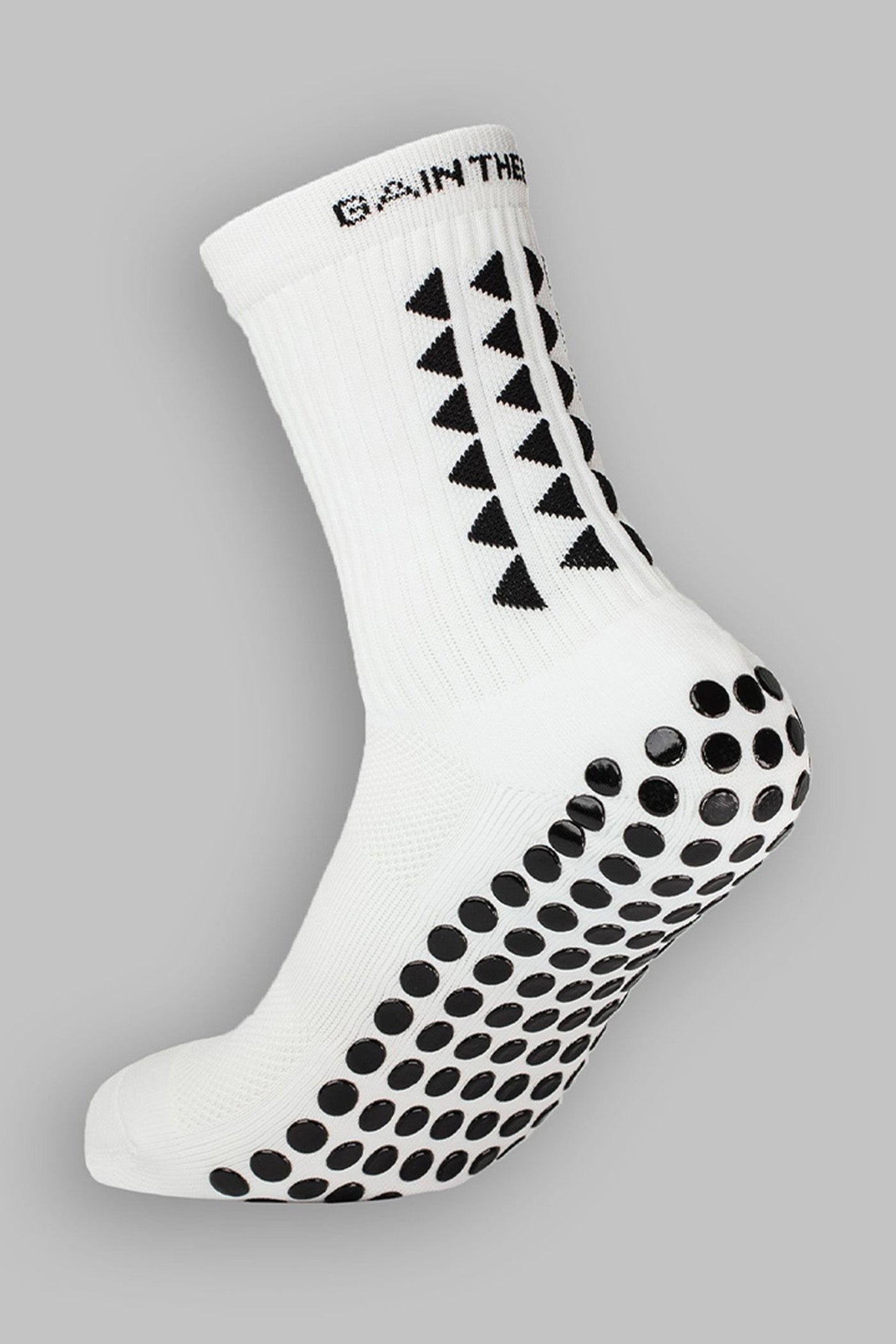Compression socks are designed to provide graduated leg compression, which means the pressure is greater at the ankle and decreases as it moves up the leg. While compression socks have several benefits, their necessary tightness can make them challenging to put on.
Compression socks are typically recommended for people with circulation problems, such as deep vein thrombosis (DVT), varicose veins, or lymphedema- all common conditions associated with aging.
Seniors often experience limited mobility, dexterity, or strength in their hands or arms, adding to the challenge of putting compression socks on.
In this article, we look at easy-to-put-on compression socks for elderly people and their benefits.
What this article covers:
- Easy Compression Socks for Elderly People
- Benefits of Compression Socks for the Elderly
- Compression Socks for the Elderly: Buyer's Guide
Easy Compression Socks for Elderly People
When choosing compression socks for the elderly, it's essential to consider the level of compression needed. Mild compression socks (8-15 mmHg) are typically recommended for seniors with mild swelling or discomfort.
Higher compression levels may be necessary for seniors with more severe swelling or circulatory issues. It's also important to choose socks that are easy to put on, take off, and are comfortable to wear for extended periods. You should remove compression socks at night to allow your skin to breathe.
Gain The Edge Compression Socks
Gain The Edge Compression Sock V1 is designed to optimize comfort while providing all the benefits of compression socks. Our socks are made with cotton for breathability and moisture-wicking properties.
Elastic fibers woven with the sock ensure effective compression. Gain The Edge compression socks have a non-binding top to promote circulation and prevent irritation.
Generally, it is safe to wear compression socks all day. With mild compression and soft, stretchy material, our socks are great for all-day comfort and support. Mild compression socks suit older people who spend long periods standing or sitting.
Our mild compression socks may also be recommended for individuals with mild to moderate venous insufficiency who do not require medical-grade compression.
Why They’re Great
- Premium fabrics: Our cotton-rich socks offer breathability and moisture-wicking properties.
- Outstanding cushioning and protection: The thickness of our socks helps safeguard fragile skin on feet and legs from injury.
- Snug Fit - elastic fibers provide a comfortable fit that molds to the shape of your foot.
- Graduated compression: Designed to improve blood flow and reduce leg swelling.
- Additional stability: The small silicone grips on our compression grip socks make it easier for the wearer to maintain balance and stability.
Who It’s Right for
- Older adults who want to improve blood circulation and reduce swelling in their legs and feet.
- People who stand or sit for long periods and who want to prevent blood pooling in their legs.
- Athletes and fitness enthusiasts want to enhance performance and aid recovery after exercise.
Benefits of Compression Socks for the Elderly
Improve Blood Circulation
As we age, our circulation can become less efficient, leading to swelling and discomfort in the legs and feet. Compression socks are designed to provide graduated pressure to the legs, which means the pressure is highest at the ankle and gradually decreases as the sock moves up the leg.
When we stand or sit for long periods, the blood flow in our legs can become sluggish. The force of gravity makes it harder for the blood to flow against it, and the veins in our legs have to work harder to move blood back up to the heart.
So how do compression socks work? Compression socks works by gently squeezing the veins and increasing the blood flow velocity, which helps prevent blood from pooling in the legs. The pressure can reduce the risk of blood clots and other circulatory problems and help to alleviate symptoms like swelling and discomfort.
Prevention of Varicose Veins:
Varicose veins are a common condition that can cause discomfort and pain in the legs, especially for elderly individuals who may spend a lot of time sitting or standing.
Varicose veins are often weakened and may not be able to push blood back up to the heart effectively. Compression socks help squeeze the veins and improve their function by applying pressure to the legs. The pressure helps to reduce the diameter of the veins and encourages blood to flow more efficiently toward the heart.
Alleviation of Leg Discomfort
Elderly individuals may experience pain, fatigue, and discomfort in the legs and feet due to various conditions, including arthritis, osteoporosis, and neuropathy.
Arthritis is a condition typically caused by wear and tear in the joints. It leads to inflammation and joint pain resulting in leg discomfort in older people. Osteoporosis causes the bones to become weak and brittle, which can cause pain and discomfort in the legs.
Neuropathy is caused by disease or nervous system injury and can cause tingling, numbness, or leg pain.
Compression socks can help alleviate these symptoms by improving blood flow and reducing swelling.
Improved Recovery After Surgery
Elderly individuals may take longer to recover from surgery, as their bodies may not be as resilient as they once were. Compression socks can help improve recovery time by reducing swelling and inflammation in the legs and feet, speeding up healing.
After surgery, the body's natural response is to increase blood flow to the affected area, which can lead to swelling. Compression socks can help reduce this swelling by applying pressure to the legs, which helps to move excess fluid away from the affected area.
One of the most significant risks after surgery is the formation of blood clots in the legs, which can be life-threatening if they travel to the lungs or other vital organs. Compression socks can help prevent blood clots from forming by improving circulation and reducing blood pooling in the legs.
A further benefit of compression socks is pain reduction after surgery by supporting the legs and reducing swelling. This can make it easier to move around and perform activities of daily living, which can help to speed up the recovery process.
Reduced Risk of Falls
Falls are a significant concern for the elderly, as they can result in severe injuries and complications. Compression socks can help reduce the risk of falls in older people by improving their balance and stability.
Compression help improves blood circulation, which helps prevent dizziness, lightheadedness, and other symptoms that can increase the risk of falls. Compression socks can also help reduce swelling in the legs and feet, making it easier for older people to move around and maintain their balance.
The slight pressure sensation created by compression socks may improve balance and reduce the risk of falls.
It is important to note that compression socks are not a substitute for other fall prevention measures, such as regular exercise, home safety modifications, and medication management.
Reduce Lymphedema
Lymphedema is characterized by the accumulation of lymphatic fluid in the body tissues, leading to swelling, discomfort, and potential complications. Elderly individuals are more likely to develop lymphedema due to age-related changes in the lymphatic system.
Other risk factors include chronic conditions such as diabetes, heart disease, or cancer, obesity, and prior surgeries or radiation therapy. Compression socks work by exerting pressure on the affected area, which helps to move the fluid out of the affected tissues and toward the lymph nodes.
Compression Grip Socks For Older Adults
Compression socks with grips are compression socks with added traction on the bottom to provide additional grip and stability. They are often used by people who need extra support and stability when walking on slippery surfaces or practicing exercises requiring balance.
Like regular compression socks, grip compression socks typically feature a graduated compression design that helps improve blood flow and circulation in the feet and lower legs.
The grips on the bottom are usually made of silicone or other non-slip materials that provide traction and prevent slipping.
Compression socks with grips can benefit older adults, people with mobility issues, and those with conditions that affect their balance or coordination.
Compression Socks for the Elderly: Buyer's Guide
Compression Level
The first thing to consider is the compression sock levels. Compression levels are measured in millimeters of mercury (mmHg) and range from 8-40 mmHg.
For the elderly, starting with lower compression levels, around 8-15 mmHg is best. However, if they have severe circulation problems, they may need higher compression levels, up to 20-30 mmHg.
The pressure the socks provide is measured in millimeters of mercury (mmHg). Compression socks are available in a range of compression levels, which can be confusing for consumers trying to select the right compression level for their needs.
- Mild Compression (8-15 mmHg): This level of Compression is best for those who stand or sit for long periods and those who experience mild swelling or discomfort in their legs.
- Moderate Compression (15-20 mmHg): This compression level is suitable for mild to moderate swelling and those at risk of developing varicose veins or deep vein thrombosis (DVT).
Material
Compression socks are typically made of synthetic materials like nylon, polyester, or spandex. These materials are stretchy, lightweight, and breathable, making them ideal for everyday wear. For older people with sensitive skin, choosing socks made of soft, hypoallergenic materials is best.
Size
Choosing the right compression sock size is crucial to ensure they are effective. It is essential to accurately measure the older adult's legs and feet to find the right size. Compression socks that are too loose will not provide the desired benefits.
But what happens if compression socks are too tight? Compression socks that are too tight can cause discomfort and even harm. Tight compression socks can rub against the skin, causing irritation and sores.
Wearing compression socks that are too tight can also decrease blood flow. The compression can constrict blood vessels and limit circulation. Likewise, tight compression socks can compress nerves, leading to tingling, numbness, and even nerve damage if worn for prolonged periods.
Style
Compression socks come in various styles, including knee-high, thigh-high, and pantyhose. Knee-high compression socks are the most popular, but thigh-high and pantyhose-style are available. For elderly individuals with mobility issues, knee-high or thigh-high compression socks may be easier to put on and take off.
Note that there is a difference between compression socks and sleeves. Compression socks cover the entire foot and leg, while compression sleeves only cover the calf and lower leg.
Both types of compression garments can be beneficial for improving circulation. However, compression sleeves are better suited to fitness enthusiasts who want to improve blood flow over calf muscles during a workout.
Ease of Use
Some compression socks can be challenging to wear and take off, especially for those with decreased mobility or arthritis. Look for compression socks that are easy to slip on and take off, with features like wide cuffs or zippers.
Conclusion
If you’re an older adult, then you’re more prone to poor blood circulation and swelling in the feet, ankles, and legs, which can be uncomfortable and even painful. Compression socks help improve circulation by gently squeezing the legs to encourage blood to flow back to the heart.
Compression socks can also provide additional support to the legs and feet, which can be beneficial for those with arthritis or other conditions that affect the lower extremities.
Compression socks can be a simple and effective way for older adults to manage various health concerns and improve their comfort and well-being.
However, it's essential to talk to a healthcare professional before using compression socks to ensure they are appropriate for your individual needs.
Did our blog meet your needs? You might also find our other guides helpful:
- What Do Compression Socks Do?
- Best Compression Socks
- How Long to Wear Compression Socks for
- How to Put on a Compression Sock
- How to Measure for Compression Socks
- Wearing Compression Socks Too long
- How to Wear Compression Socks
- Best Running Socks
- Running Socks: Women
- What Do Grip Socks Do?
- What Are Ankle Socks?
- How to Wear Grip Socks
- Do Running Socks Make a Difference?
- Compression Socks for Runners
- Best Walking Socks
















